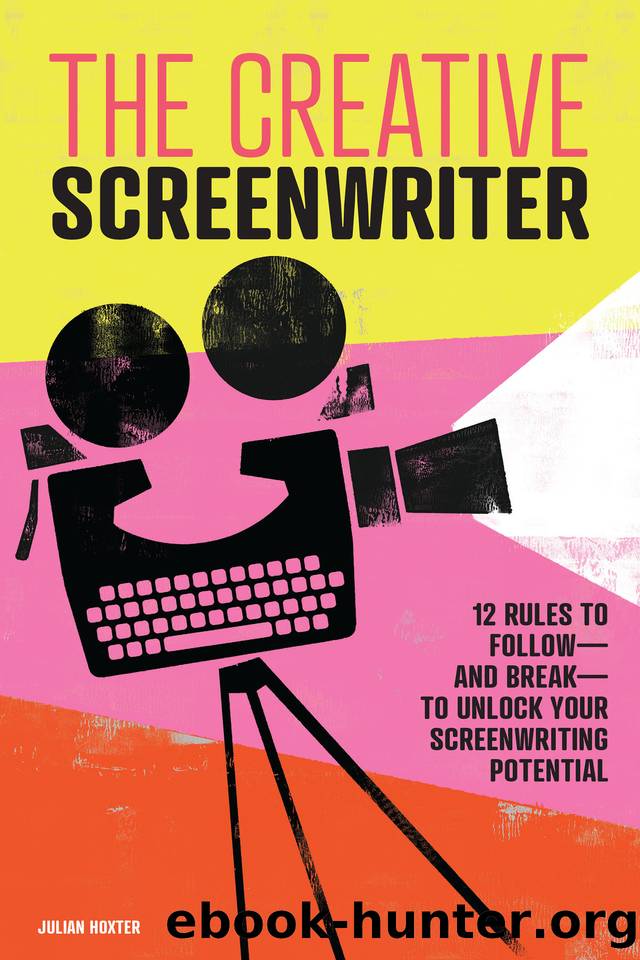The Creative Screenwriter: 12 Rules to Follow—and Break—to Unlock Your Screenwriting Potential by Hoxter Julian

Author:Hoxter, Julian [Hoxter, Julian]
Language: eng
Format: epub
Publisher: Rockridge Press
Published: 2020-08-03T16:00:00+00:00
A Hero’s Journey
Vogler’s approach to storytelling is steeped in the structure of myth, so of course he’s drawn to archetypes. The Writer’s Journey is deeply influenced not only by Jung, but also by the work of literary scholar Joseph Campbell. Campbell’s ideas became influential in Hollywood in the 1970s after George Lucas and other young filmmakers championed his book, The Hero with a Thousand Faces . There, Campbell posits the concept of a “monomyth,” as heroic stories from across cultures share common structural tropes.
Vogler’s book updates and translates Campbell’s work into the vernacular of Hollywood screenwriting, moving toward Jung to suggest that myths are “like the dreams of an entire culture, springing from the collective unconscious.” What is appealing about Vogler’s approach is the way he looks at archetypes as flexible character functions. In any story, an archetype can manifest in certain behaviors rather than being the constant and defining trait of a particular character. A character might behave like a Mentor at one point in a story without necessarily being defined or bound by that archetype throughout.
In Clueless (1995), the protagonist, Cher, gives a memorable speech on immigration in her high school debate class. Her analogies to party crashing are insane, yet somehow apt, and she ends with a truly great line, reminding her classmates “. . . that it does not say RSVP on the Statue of Liberty.” Is Cher really a Mentor? She does have Mentor tendencies but, as a compulsive matchmaker trying to help everyone she meets, she’s primarily a weird version of Truby’s Lover, or Vogler’s Hero . Even so, her wacky Mentor-ing certainly resonates as she adopts that archetypal function at this point in the story.
The following are Vogler’s most common archetypes. You’ll see how they overlap with Truby’s. I have used examples from Star Wars: Episode IV – A New Hope , because the movie’s structure was strongly influenced by Campbell’s writing.
Over the course of the original Star Wars trilogy, several characters change their primary archetype, in particular Han Solo, Darth Vader, and Princess Leia. It is important to note that some of the terms, like Threshold Guardian, are chosen to fit into the beats of the structural model of mythic storytelling Vogler adapts from Campbell.
THE HERO
Luke Skywalker wants to be more than a moisture farmer.
THE MENTOR
Obi-Wan Kenobi wants to help Luke become a Jedi.
THRESHOLD GUARDIAN
Minor villains and obstacles. There are many options here, but remember those nasty guys in the cantina? Yeah, well they don’t like you, either.
HERALD
R2-D2 brings Leia’s message.
SHAPESHIFTER
Leia, because she takes on different roles and functions.
SHADOW
Darth Vader; he’s the darkness in Luke’s world.
ALLY
Chewbacca is the loyal friend (and occasional critic) to Han and others.
TRICKSTER
Han Solo. Just ask Greedo.
Vogler suggests that we can look at the archetypes as facets of the hero’s personality, as well as story functions. That’s because each archetype has a psychological as well as a dramatic function. According to Vogler, the Hero’s psychological function is to represent the ego. The mythic hero’s journey can be read
Download
This site does not store any files on its server. We only index and link to content provided by other sites. Please contact the content providers to delete copyright contents if any and email us, we'll remove relevant links or contents immediately.
The Kite Runner by Khaled Hosseini(5063)
Gerald's Game by Stephen King(4557)
Dialogue by Robert McKee(4311)
The Perils of Being Moderately Famous by Soha Ali Khan(4157)
The 101 Dalmatians by Dodie Smith(3440)
Story: Substance, Structure, Style and the Principles of Screenwriting by Robert McKee(3385)
The Pixar Touch by David A. Price(3347)
Confessions of a Video Vixen by Karrine Steffans(3231)
How Music Works by David Byrne(3159)
Fantastic Beasts: The Crimes of Grindelwald by J. K. Rowling(2981)
Harry Potter 4 - Harry Potter and The Goblet of Fire by J.K.Rowling(2975)
Slugfest by Reed Tucker(2924)
The Mental Game of Writing: How to Overcome Obstacles, Stay Creative and Productive, and Free Your Mind for Success by James Scott Bell(2837)
4 - Harry Potter and the Goblet of Fire by J.K. Rowling(2640)
Screenplay: The Foundations of Screenwriting by Syd Field(2562)
The Complete H. P. Lovecraft Reader by H.P. Lovecraft(2500)
Scandals of Classic Hollywood: Sex, Deviance, and Drama from the Golden Age of American Cinema by Anne Helen Petersen(2455)
Wildflower by Drew Barrymore(2432)
Robin by Dave Itzkoff(2371)
